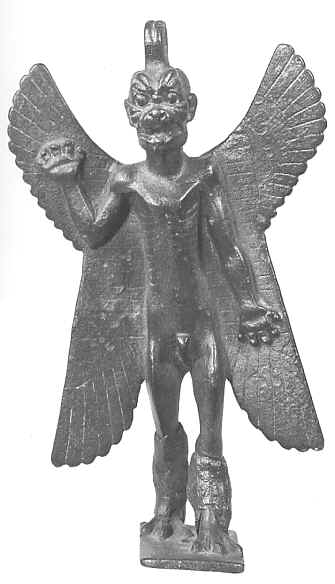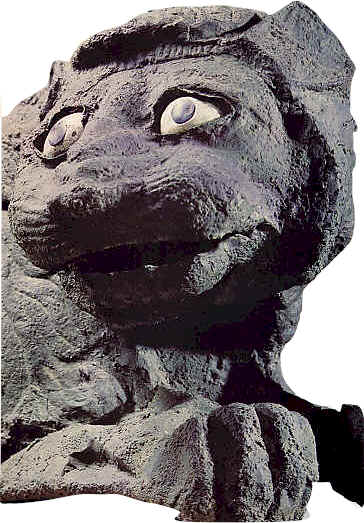Only if this is a bird...lol

Posted on 10/17/2006 6:10:35 AM PDT by NYer
I am standing above an archaeological dig, on a hillside in southern Turkey. Beneath me, workmen are unearthing a sculpture of some sort of reptile (right). It is delicate and breathtaking. It is also part of the world's oldest temple.
If this sounds remarkable, it gets better. The archaeologist in charge of the dig believes that this artwork once stood in Eden. The archaeologist is Klaus Schmidt; the site is called Gobekli Tepe.
In academic circles, the astonishing discoveries at Gobekli Tepe have long been a talking point. Since the dig began in 1994, experts have made the journey to Kurdish Turkey to marvel at these 40-odd standing stones and their Neolithic carvings.
But what is new, and what makes this season's dig at Gobekli so climactic, is the quality of the latest finds - plus that mind-blowing thesis which links them to Paradise.
The thesis is this. Historians have long wondered if the Eden story is a folk memory, an allegory of the move from hunter-gathering to farming. Seen in this way, the Eden story describes how we moved from a life of relative leisure - literally picking fruit from the trees - to a harsher existence of ploughing and reaping.
And where did this change take place? Biologists now think the move to agriculture began in Kurdish Turkey. Einkorn wheat, a forerunner of the world's cereal species, has been genetically linked to here. Similarly, it now seems that wild pigs were first domesticated in Cayonu, just 60 miles from Gobekli.
This region also has Biblical connections, tying it closer to the Eden narrative. Muslims believe that Sanliurfa, a nearby city, is the Old Testament city of Ur. Harran, a town down the road, is mentioned in Genesis twice.
Even the topography of Gobekli Tepe is 'correct'. The Bible describes rivers descending from Paradise. Gobekli Tepe sits in the 'fertile crescent' between the rivers Tigris and Euphrates. The Bible also mentions mountains surrounding Eden. From the brow of Gobekli's hills you can see the Taurus range.
But how does this intoxicating
notion link to the architecture of Gobekli, and those astonishing finds?
Klaus Schmidt (left) explains: "Gobekli Tepe is staggeringly old. It dates from 10,000BC, before pottery and the wheel. By comparison, Stonehenge dates from 2,000BC. Our excavations also show it is not a domestic site, it is religious - the world's oldest temple. This site proves that hunter-gatherers were capable of complex art and organised religion, something no-one imagined before."
As for the temple's exact purpose, Schmidt gestures at a new discovery: a carving of a boar, and ducks flying into nets. "I think Gobekli Tepe celebrates the chase, the hunter-gatherer lifestyle. And why not? This life was rich and leisured, it gave them time enough to become accomplished sculptors."
So why did the hunters of Gobekli give up their agreeable existence? Schmidt indicates the arid brown hilltops. "Gathering together for religion meant that they needed to feed more people. So they started cultivating the wild grasses." But this switch to agriculture put pressure on the landscape; trees were cut down, the herds of game were dispersed. What was once a paradisaical land became a dustbowl.
Schmidt explains that this switchtook place around 8,000BC. Coincidentally, the temple of Gobekli Tepe was deliberately covered with earth around this time.
We may never know why the hunter-gatherers buried their 'temple in Eden'. Perhaps they were grieving for their lost innocence. What is unquestionable is the discoveries made in Gobekli Tepe, in the last few weeks, are some of the most exciting made anywhere in half a century.
Schmidt shows me some workmen scraping earth from a rock relief (left). It is marvellously detailed: it shows scorpions, waterbirds, and river life. I suddenly realise I am the first person other than an archaeologist to see it in 10,000 years.
All good and fine but the Asian east has good rainfall, hi-IQ people, thus is a natural for early development of agriculture... thus moving away from hunting gathering... likely coinciding with the retreat of ice age glaciers and world getting warmer
They are holding it back until Jan 20th and will be released if and only if the dems win both houses.
I see Oannes as I would see a shaman wearing the head and skin of an animal.
I would look to AFrica for the garden of eden.
See http://blogs.nationalgeographic.com/channel/blog/2005/06/explorer_adam.html
A fish, though?
See PARADISE PARCHED here:
http://links.jstor.org/sici?sici=0149-6611%28195901%2974%3A1%3C7%3APP%3E2.0.CO%3B2-U&size=LARGE
Thanks.
Job of the Bible hears from a retainer that "the fire of God is fallen from heaven and hath burned up the sheep [to the number of 7000], and the servants, and consumed them, and I only am escaped alone to tell thee." (In our days cases of a score or more animals being electrocuted by a lightning bolt are recorded.) There begins then the woes of the stubbornly patient Job against frightful divine tests. It is only one of many references to naturally caused combustion in the Bible. The story of Job may be exceedingly old; there Elohim (Heavenly One) is addressed; it happened in full Neolithic times, perhaps at the ending of the age of predominantly Saturn worship [6] .
Later in reference to fire is the "flaming sword", east of the Garden of Eden, "which turned every way, to guard the way to the tree of life." This was after the "Fall from Grace." [7] The image of a sword in the sky may refer to the Great Central Fire of early Greek Philosophy...
http://www.grazian-archive.com/quantavolution/QuantaHTML/vol_04/lately_tortured_earth_07.htm
Only if this is a bird...lol

I'm puzzled. These references are pre-Noah's Flood, correct?
And Noah's Flood changed everything, right?
So how did these two rivers survive the Flood and remain the same today?

http://www.ezida.com/balade%20feline%20photos.htm
Lots of Lions!
http://oi.uchicago.edu/OI/IS/SANDERS/PHOTOS/meso_map.html
do you have this link? armchair archeology tour.
I do now, thanks.
German Paper Reports World’s Oldest Temple Is In Sanliurfa
(Turkey- 10,000BC)
Turkish Daily News | 1-21-2006
Posted on 01/21/2006 1:34:38 PM EST by blam
http://www.freerepublic.com/focus/f-news/1562301/posts
Is this the world’s oldest statue? [Anatolia, Gobekli Tepe]
The First Post | November 24, 2006 | Sean Thomas
Posted on 11/26/2007 12:01:06 PM EST by SunkenCiv
http://www.freerepublic.com/focus/f-chat/1930666/posts
Call me when they find the apple core....
When they are confronted by an Angel with a Flaming Sword then they are close!
One day, far in the future, archaeologists will find Jet aircraft that were buried in the desert by Saddam. Wonder what they will think?
As schoolchildren here in California, we were taught about the Costanoan Indians and all the elaborate steps they had to take to render the live oak (a type of black oak, it has the "spiny" leaves) acorns edible. Gather and hull, grind and leach, leach, leach all that nasty tannin away.
Disclaimer: Opinions posted on Free Republic are those of the individual posters and do not necessarily represent the opinion of Free Republic or its management. All materials posted herein are protected by copyright law and the exemption for fair use of copyrighted works.